September 3, 2007
Supports Raid 0, 1, 5 or Raid 6
2.0TB to 8.0TB Capacity
Starts at $3,999.00 for 2TB system
CalDigit
Review by Shane Ross
Not long ago...January 2007...I was at MacWorld
in San Francisco. There was a LOT of buzz going around about
a great many things. The iPhone was announced, Leopard was demoed,
a company converted a MacBook into a tablet
computer...there was no end to the cool things to see. But
all the companies that were there showing off storage solutions...RAID
solutions...were hit by one big question.
"Does this do Raid 5?"
Well, I can tell you, that a VAST majority of the
answers were "Sorry, no. Only Raid 0 or Raid 1." This
turned many people away. The only people who could say "Why
yes, we do!" were the Fibre
channel solutions. But, as you might suspect, those solutions
were EXPENSIVE. Restrictively so for many of us.
My how technology flies.
Here we are...8 months later...and the companies
who were at MacWorld (and NAB) heard the cry. One such company
was CalDigit.
Their offering, the HDPRO, offers what everyone desires...hardware
Raid 5 support. For a device to offer "Hardware RAID"
it must have 2 things: An IO Processor (CPU) and a Cache Memory.
This unit has both.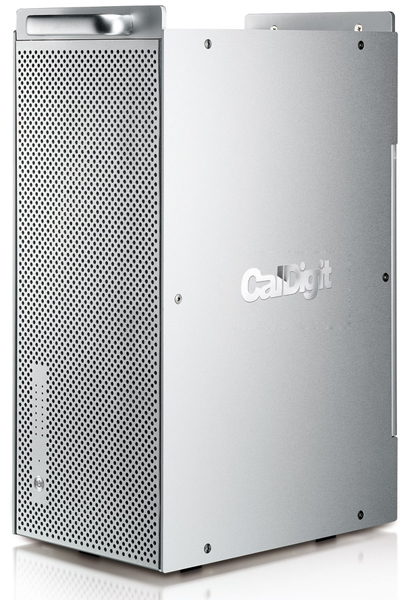
What is Raid
5? Well, let us first start with the lower numbers.
RAID 0 is what is called PERFORMANCE RAID. What
you do is take two or more drives and "stripe" them
together so they act as ONE DRIVE. "Striping" essentially
means you format multiple hard drives together as one large "virtual"
hard drive for your system." For example, if you take four
250GB drives and stripe them RAID 0, you'd have a 1TB Raid. In
doing this, you spread out the information that is being written
onto all the drives so that you get faster data transfers. This
means that you can capture uncompressed video formats and play
them back. The more drives you add, the faster the raid, the
better the performance.
RAID
1 is known as a PROTECTION RAID. You take 2 or more drives (need
to be in pairs) and group them so that they again appear as one
drive, but this time the information is MIRRORED. If you took
two 250GB drives and striped them as RAID 1, you'd have a 250GB
drive, but the information would be secure because the information
on one drive is copied to the other drive as well. The drives
are exact duplicates of each other. The good thing is that your
media is safe, the drawback being that your drive performance
isn't as great, and you cannot really work with uncompressed
formats.
RAID 5 is the best
of both worlds. Performance with protection. RAID 5 stripes both
data and parity information across three or more drives. It doesn't
have one dedicated parity drive that contains all the information,
but rather distributes the data and parity blocks across all
the drives in the array. "What the heck did you just say
Shane? What does all that mean?" To tell you the honest
truth...I don't understand the inner workings of the engineering.
I am not an engineer, I am a creative editor. But I DO know that
it basically means that your footage and the backup information
is not on one drive, but spread across many. So that if one drive
fails (and drives are known to do this, more often than we care
to admit) your information is still safe.
If you want to know more about the RAID types,
go to the Wikipedia.
Enough with the schooling...let's get to the HD Pro itself.
First off, I must mention that
currently the HD Pro ONLY WORKS WITH PCIe MACHINES (PCI-X support
due by mid-September I hear). This means it works only on the
newer MacPros, and the older G5 Quads with a PCIe slot. Now,
I don't have one of these machines, I have a PCI-X G5 with a
Kona LH capture card. I needed a PCIe machine with capture
card in order to do this test. So for the purpose of testing,
I was loaned a MacPro
(Dual-core 2.66Ghz model) with a Decklink
Multibridge Pro capture card.
When
I went to unpack the unit, I encountered something similar to
what I encountered when I unpacked the S2VR
Duo unit. The hard drives were not inside the unit. They
were all tucked into little cut out sections of the packing foam
that encased the drive chassis. This is clever, for it helps
prevent damage that can occur by jostling the unit. We know how
gently delivery services are with packages, right? So I pulled
out all the drives from their safe cubbies, removed them from
the plastic wrap, and installed them into the chassis. They were
all conveniently labelled A0, A1, A2 so I knew what order to
install them.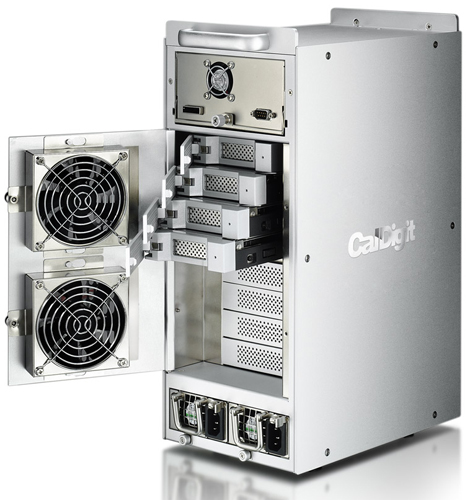
Another interesting
thing is that the card that you install inside the MacPro is
a VERY small and basic card. It is a 4-lane one port card, with
no real electronics to speak of. The card doesn't have the controller
on it. Nope...it is simply a BRIDGE from the board to an external
connection that a PCI Express cable connects to. The controller
is INSIDE the chassis. To quote the website, " This direct
link eliminates latency introduced by the conversion of other
interfaces to PCI Express and provides superior bandwidth, availability
and deployment flexibility over earlier-generation SCSI
and Fibre Channel technology." The reason for this is two-fold.
First, it doesn't contribute to the heat inside your MacPro...since
you will have plenty with your DOUBLE-WIDE graphics card and
your capture card. And second, it allows for controlling MULTIPLE
units with the aid of a PCIe switch (not out yet). Meaning that
your machine can control more than one HD Pro box...you can add
more units as the need arises. Just like I can now with my eSATA
boxes and my port multiplier card. Room to grow.
The test unit I received was a 4TB unit. Eight
500GB drives. When I fired up the unit it appeared on the desktop,
ready to go. It was already configured...Raid 5 and everything.
So I ran the AJA test with the following result: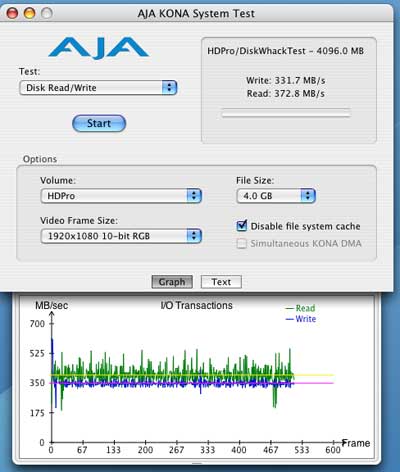
331 Write
/ 372 Read. RAID 5!! Plenty fast for uncompressed HD...a couple
streams of uncompressed HD. Niiiiice. But, me being me and not
trusting the integrity of a drive format after shipping...and,
well, to see what is involved in setting up a RAID 5, I did it
myself. CalDigit includes a handy little pamphlet on how to do
this, so I won't go into the boring details. But I will mention
that it did take 3 hours to build the RAID...which is slightly
faster than I hear RAID 5 takes to build on an XServe. Do note
that the size of your Raid determines how long it will take to
build. 8TB will take longer to build than 2TB. Makes sense. So,
I let it do it's thing while I ate dinner, played with the kids,
and tucked them into bed.
When
the building was done, I ran the AJA test again: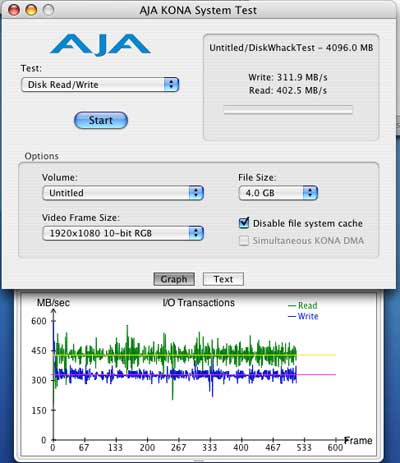
311 Write
and 402 Read....again, niiiiice. The Write was a little slower,
but who really needs more than 250 anyway? I am not CAPTURING
multiple streams...so 300 to 340 is fine. The Read increased,
which was cool. And I suppose the average will be about 320 Write
and 385 Read...which is VERY nice indeed.
I captured a few different ways. First DVCPRO HD
native via firewire. No sweat...but I can do that with my G-Raid.
So then I captured uncompressed 8-bit 720p...no problems. Uncompressed
10-bit 720p...no problems. Uncompressed 10-bit HD...passed again
without one dropped frame.
OK,
time to abuse this thing. Again I set it up to capture uncompressed
10-bit, and about 5 minutes in...I YANKED A DRIVE OUT! Just so
you know, this isn't something you can do by accident. There
is a pinhole that you need to push an included tool into (or
a paperclip if you lost the tool) and that pops open the handle
that you then use to disengage the drive and pull it from the
chassis. When I did this it did give me this nice little warning: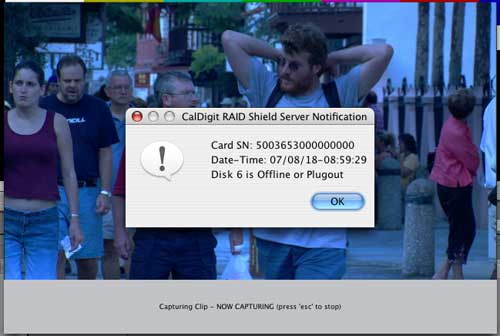
But, it kept
merrily match capturing...not missing a beat. When it was done
I saved my project and set about fixing what I intentionally
broke. I pushed the drive back in and went into the RAID SHIELD
software and unlocked the drive and the software went about rebuilding
the Raid. Again, that took about 3 hours. But the footage I captured
was still intact and played fine.
OK,
now let's look at playback. I was able to get 9 streams of DVCPRO
HD playback (both firewire and Decklink encoded DVCPRO HD)...I
resized my footage to look like the opening to THE BRADY BUNCH.
The first 4 streams gave me no render bar whatsoever. When I
hit 5 streams I encountered the dark green render bar, which
means high quality playback. Eight streams got me the light green
render bar....low quality playback...and that held up until I
added the 10th stream...when it went RED. So i stuck with nine.
Since it was getting late, and I had work in the morning, I just
let it play this footage as I went to bed, setting Final Cut
Pro to loop the footage(did I mention I was testing this with
Final Cut Pro? No? Sorry).
I
woke up, went to work, came back home, had dinner, then went
"oh yeah, I have something going on in my office."
I turned my monitors on and there the footage was, happily playing
along. No dropped frames.
But
hey...seriously....DVCPRO HD footage? Was that a REAL test? OF
COURSE NOT! So I went to the 8-bit uncompressed 720p footage.
I started layering that. I got the dark green render bar after
two layers, light green after 3 and the red render bar when I
hit five. So four streams it is. I tried 10-bit uncompressed
and couldn't get more than two. But really...uncompressed 10-bit...I
am not offline editing with this codec. I am FINISHING with it,
so two streams is plenty. I am offlining with DVCPRO HD, and
getting nine RT streams is a nice thing to have. OH, and I was
able to add the 3-way color corrector to seven streams and stay
RT.
Time for bed again, so
I resized the uncompressed 8-bit footage into four windows, and
pressed play. This time I let it run for 3 days. Every time I
came back, it was running. On the third day when I got back from
work, I walked in, opened the unit, and yanked a drive. I turned
on the monitor and again, saw the warning, but playback wasn't
affected. Kept going and going and going. So I let it go. Went
to bed. Woke up the next morning to see it still humming along...footage
playing. I stopped...saved...quit...and set the raid to rebuild
again. And again, when it was done, all my footage was still
there...safe and sound.
The
HD Pro unit was running for the entire 8 days that I had it...I
didn't turn it off. When I finally did, and I removed a drive
and felt it...is was warm to the touch, but not overly hot. The
RAID SHIELD software has temperature monitoring capabilities,
so you can always check and see how hot things are. OH, and I
forgot to mention that you can set up e-mail notification so
when a drive does happen to die and you are...somewhere else...you'll
get an e-mail telling you a drive failed. Very handy.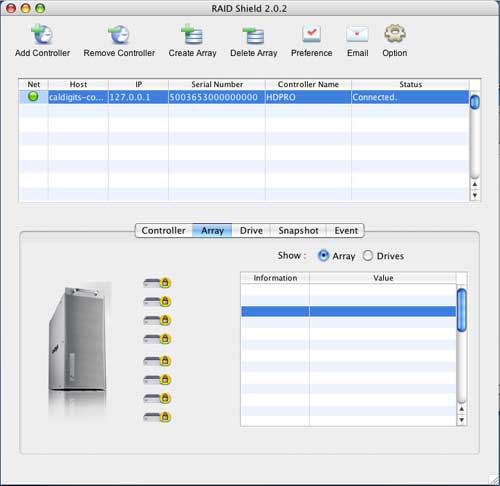
So I am rather
impressed with this. And I would easily consider it for use in
my edit bay. The piece of mind that RAID 5 gives you is something
EVERYONE should experience. Currently I am running a RAID 0 box,
and have all the footage backed up to a couple firewire drives.
A sort of manual RAID 1. With this box I wouldn't need to waste
the drive space. It would be an invaluable asset to any edit
bay.
OH! OH! OH! AND...oh
I love this...AND CalDigit makes an Express34 card for this unit,
so you can use it with your MACBOOK PRO! You won't get nearly
the numbers you get with the tower, but the numbers you do get
are QUITE impressive: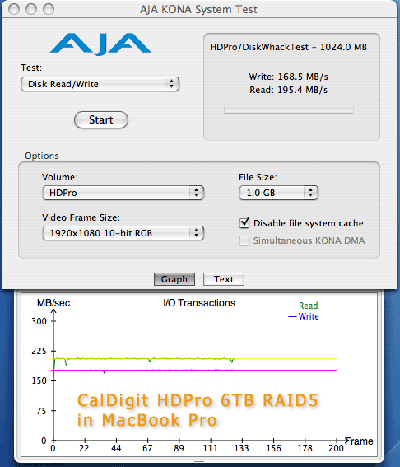
168 Write
and 195 Read. PLENTY for uncompressed SD and even uncompressed
8-bit HD work. And for DVCPRO HD and the new ProRes format, that
would be plenty for several streams of playback...ON A LAPTOP!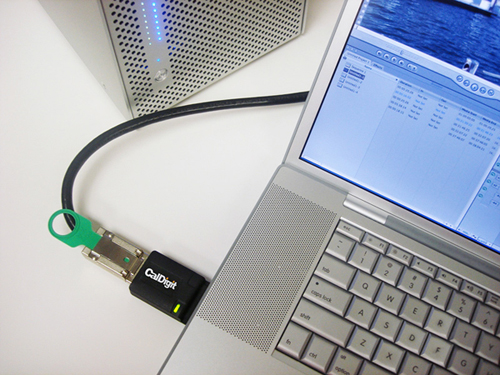
Man...time
for me to get a MacPro...or
MacBook
Pro.
Shane Ross is a freelance editor residing in Los Angeles. He edits shows for The History Channel, Discovery Channel, National Geographic and Nickelodeon.
copyright © Shane Ross 2007